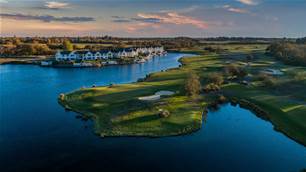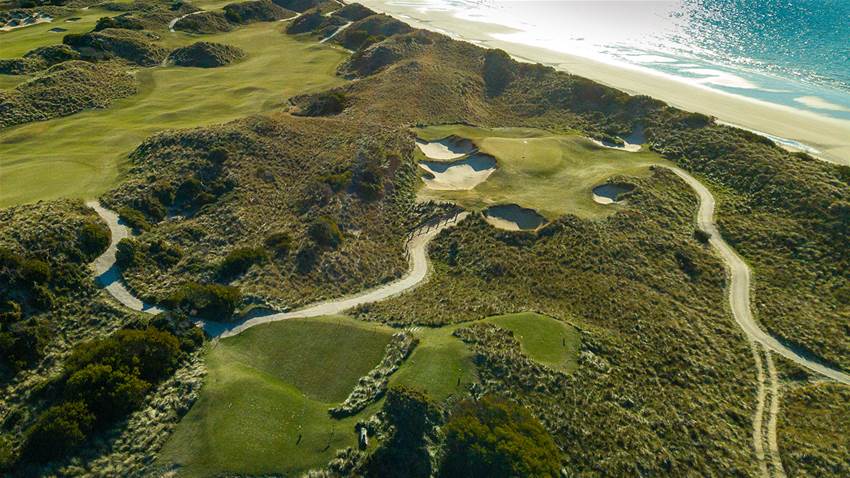Bigger is not always better and, when it comes to golf, the shortest offerings can often provide the most memorable moments during a round. They can be the most picturesque and, in many cases, they can be the most difficult holes.
NEW SOUTH WALES & ACT (continued)
NEW SOUTH WALES GC
177-metre, 6th hole
This famous hole has undergone some changes in recent times with the green being re-shaped and moved closer to the water. From the back tee, perched on a rocky outcrop, your tee shot must fly over the edge of the ocean and a small beach to find the green. This is perhaps the most memorable short hole in Australian golf and rarely plays the same way twice.

NEW SOUTH WALES GC
149-metre, 11th hole
The elevated 11th tee occupies one of the highest points of the layout and, therefore, is well exposed to the elements. The green, which slopes markedly from back to front, calls for a tee shot to finish below the hole for a good chance at birdie.
ST MICHAEL’S GC
176-metre, 12th hole
One of the most daunting par-3s to be found in Sydney, even on a windless day. Surrounded by a nest of bunkers, steep drop-offs and hollows, the green is relatively small and features plenty of slope from back left to front right. The safe play here is to aim at the right edge of the putting surface.

THE AUSTRALIAN GC
157-metre, 11th hole
The 11th has been the scene of plenty of drama in Australian Opens past. Much of this can be attributed to the green complex and the difficult tee shot it demands. The green is angled diagonally from left-to-right, with the wide front narrowing above a steep tier that runs from front-to-back between two bunkers.
THE LAKES GC
160-metre, 7th hole
With a green that slopes markedly from back right to front left, the 7th is a hole with numerous scenarios. The required shot will change markedly here depending on the tee and flag positions as well as the wind direction. The best play here is to always aim for the left front of the green to avoid slick downhill putts and the sea of sand to the right.

THE LAKES GC
138-metre, 9th hole
A demanding little one-shotter where an accurate tee shot in the wind from the high dune is more easily said than done. Two spines running through the green can prove problematic for long putting.
THE VINTAGE GC
194-metre, 8th hole
The visual of water all down the right of the hole and green, with bunkers crammed into the left edge of the putting surface, can be daunting. But designers Greg Norman and Bob Harrison created two playing lines to the flag – the aggressive all-or-nothing at the flag shot and the conservative line where a running shot at the left half of the green will feed in close to most pin position.
THE COAST GC
180-metre, 4th hole
A beautiful natural hole with the tee and green separated by a rocky shoreline rising above
the ocean.
From the back tees (180 metres) it is a beast, especially in the prevailing southerlies, and the best ‘miss’ is short right of the putting surface. A miss anywhere else will likely result in a bogey.

TURA BEACH CC
181-metre, 5th hole
A picturesque lake separates the back tee from the front of the green, which is guarded right by a bunker and three mounds long and left.
A fairway winds around the water and shorter hitters can lay up short of the putting surface with their tee shot.
WOLLONGONG GC
141-metre, 17th hole
Despite its beachside location, the only time you get an unobstructed view of the ocean is when you stand on the 17th tee that is perched above the back of Wollongong Beach. The downhill tee shot here must avoid four bunkers and a series of mounds and hollows that ring the green. Don’t discount the difficulty of this little gem.

WESTERN AUSTRALIA
BUNBURY GC
124-metre, 10th hole
The shortest hole at Bunbury really packs a punch. From the tee, elevated nearly 40 metres above the angled green, it is difficult to judge the wind and club selection can easily be affected. Bunkers – short left and long right – add to the questions this hole asks.
KALGOORLIE GOLF COURSE
174-metre, 8th hole
Named after the ‘Super Pit’ gold mine just outside Kalgoorlie, the 8th lies across the slope of a red sand-covered hill. The contrasting couch grass fairway leads to a wide, almost boomerang-shaped, green surrounded by four bunkers. It is a desert beauty that easily slips into the top-100 Par-3s in the country.

LAKE KARRINYUP CC
201-metre, 8th hole
The most difficult par-3 to be found at Lake Karrinyup, the tee shot must not only carry 200 metres, at its longest, but it also favours the player who can move their ball from left-to-right, to avoid the bunkers short, right and long left of the angled green. Better players won’t be concerned by the lake in front of the tee but it will intimidate the higher handicapper.
LAKE KARRINYUP CC
135-metre, 12th hole
Playing downhill it is little more than a long pitch but the green is quite small and missing it makes saving par really difficult. The best miss here is into the bunker lining the left edge of the putting surface.

LINKS KENNEDY BAY
‘Wee Tap’, 132-metre, 16th hole
A terrific short one-shotter but by no means is it easy. Its length and greenside dangers make it similar to the famed ‘Postage Stamp’ hole at Royal Troon, in Scotland. The shape of the green and the bunkers – two long and one short – give the ‘Wee Tap’ some real bite.
JOONDALUP RESORT – QUARRY COURSE
135-metre, 3rd hole
The first of the ominous holes around Joondalup’s famed quarry, it is also arguably its best.
The memorable all-or-nothing tee shot over the quarry to the green is quite unique in Australian golf, while the wide variety of tees offers a range of angles and distances in which this terrific hole can be experienced.

JOONDALUP RESORT – DUNE COURSE
172-metre, 4th hole
The second of two holes played across the bottom of an abandoned quarry, the long 4th spends most of the afternoon each day in the shadow of a 35-metre high rock wall, which lines the right edge of the hole. A massive undulating green presents enough of a target that any miss will be frustrating.
MEADOW SPRINGS G&CC
155-metre, 8th hole
There are several par-3s showcased here that require long water carries over a lake adjacent to the hole. But none have the added hazard of also having a babbling brook cutting in front of the green. That’s what you’ll find on this testing one-shotter, as well as a huge undulating green surrounded by gentle humps and swales.
SECRET HARBOUR LINKS
173-metre, 17th hole
From the back tee (173 metres) it is all water carry to a wide green, with two pot bunkers squeezed between the putting surface and the lake. From the forward tees (142 metres), you can easily play alongside the lake and also avoid bunkers left of the green.
THE CUT GC
177-metre, 13th hole
Heading away from the sea, this superb one-shotter plays up to a slightly elevated green that is partially obscured by a sand dune cutting in from the left. Thankfully, given the wind that can blow here, the green is large and receptive to shots with long clubs.
THE CUT GC
134-metre, 16th hole
The tee lies on the highest point of the course and offers beautiful views across the 12th, 15th and 17th holes and beyond to the Indian Ocean.
There are no bunkers around the peanut-shaped green, which features a receptive ‘bowl’ in the front half.

THE VINES RESORT & CC – LAKES COURSE
174-metre, 16th hole
With an angled green boasting three distinct sections and a significant slope from
left-to-right, the best way to play this hole is to aim to the left half of the green and watch your ball feed towards the hole, especially if it’s positioned back right. The water to the right shouldn’t come into play.
SOUTH AUSTRALIA
GLENELG GC
168-metre, 11th hole
This is one of the more testing par-3s to be found in Adelaide, simply because it plays uphill into the prevailing wind. But the pines that surround the tee and line the first two thirds of the hole shelter you from the wind and make club selection intriguing. While there are three bunkers near the green, it is the large pit right of the putting surface that is best avoided.
Related Articles

RANKING: Australia's Top-100 Courses for 2024

Review: Clearwater Golf Club













